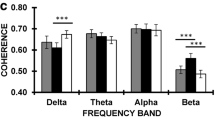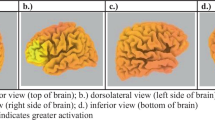Abstract
The relationships between EEG and the teachers' and parents' ratings of conduct disorder and emotional problems were studied in 20 schoolchildren between the ages of 9 to 13 years. For the assessment of behavioral and emotional problems, we used the Rutter questionnaire for teachers and the Achenbach questionnaire for parents. The intelligence was determined with the Wechsler test. The electroencephalogram was recorded at rest with eyes open and closed, from 16 derivations, using the international 10–20 system. Correlation analysis, controlling the effects of age and sex, and stepwise multiple regression analysis revealed a positive relationship between the θ1 relative spectral power and parental ratings of delinquent behavior and teachers' ratings of hyperactivity and conduct disorder. The relative spectral power of the γ band positively correlated with the intelligence and negatively, with the teachers' ratings of conduct disorder and hyperactivity. Children with high parental ratings of anxiety and depression and low teachers' ratings of hyperactivity had higher spectral power of the α band in the left occipital region than in the right region. The average difference between the spectral power of the α band in the derivations P 3 and P 4 with eyes open and closed correlated negatively with the parents' ratings of attention deficit. The discussion of the results involves the relationship between impulsiveness and arousal and the role of the right hemisphere in the generation of emotions.
Similar content being viewed by others
REFERENCES
Compas, B.E., Howell, D.C., Phares, V., et al., Risk Factors for Emotional/Behavioural Problems in Young Adolescents: A Prospective Analysis of Adolescent and Parental Stress and Symptoms, J. Consult. Clin. Psychol., 1989, vol. 57, p. 732.
Campbell, S.B., Behaviour Problems in Preschool Children: A Review of Recent Research, J. Child Psychol. Psychiatry, 1995, vol. 36, p. 113.
Egeland, B., Kalkoske, M., Gottesman, N., and Erickson, M.F., Preschool Behaviour Problems: Stability and Factors Accounting for Change, J. Child Psychol. Psychiatry, 1990, vol. 31, p. 891.
Maliphant, R. and Davies, J., Disruptive Behaviour in School: Some Data and an Additional View, Educat. Psychol. in Pract., 1990, January, p. 192.
Quay, H.C., The Psychobiology of Undersocialized Aggressive Conduct Disorder: A Theoretical Perspective, Devel. Psychopatol., 1993, vol. 5, p. 165.
Lytton, H., Child and Parent Effects in Boys' Conduct Disorder: A Reinterpretation, Dev. Psychol., 1990, vol. 268, p. 683.
Gray, J.A., Fundamental Systems of Emotion in the Mammalian Brain, in Coping with Uncertainty: Behavioural and Developmental Perspectives, Palermo, D.S, Ed., Hillsdale, NJ: Eribaum, 1989, p. 173.
Susman, E.J., Psychological, Contextual, and Psychobilogical Interactions: A Developmental Perspective on Conduct Disorder, Devel. Psychopathol., 1993, vol. 5, p. 181.
Davidson, R.J., Anterior Cerebral Asymmetry and the Nature of Emotion, Brain. Cogn., 1992, vol. 20, p. 125.
Dawson, G., Frontal Electroencephalographic Correlates of Individual Differences in Emotion Expression in Infants: A Brain Systems Perspective on Emotion, Monogr. Soc. Res. Child. Dev., 1994, vol. 59, p. 135.
Fox, N.A., Rubin, K.H., Calkins, S.D., et al., Frontal Activation Asymmetry and Social Competence at Four Years of Age, Child Dev., 1995, vol. 66, p. 1770.
Graae, F., Tenke, C., Bruder, G., et al., Abnormality of EEG Alpha Asymmetry in Female Adolescent Suicide Attempters, Biol. Psychiatry., 1996, vol. 40, p. 706.
Rutter, M., A Children's Behaviour Questionnaire for Completion by Teachers: Preliminary Findings, J. Child Psychol. Psychiatry, 1967, vol. 8, p. 1.
Achenbach, T.M., Manual for the Child Behavior Checklist /4–18 and 1991 Profile, Burlington: Univ. Vermont, Department of Psychiatry, 1991.
Wada, M., Ogawa, T., Sonoda, H., and Sato, K., Development of Relative Power Contribution Ratio of the EEG in Normal Children: A Multivariate Autoregressive Modeling Approach, Electroencephalogr. Clin. Neurophysiol., 1996, vol. 98, p. 69.
Tanimura, R., Sonoda, H., and Ogawa, T., Developmental Characteristics of Topographic EEG in School-Age Children Using an Autoregressive Model, Brain. Topogr., 1996, vol. 8, p. 261.
Somsen, R.J., van't Klooster, B.J., van der Molen, M.W., et al., Growth Spurts in Brain Maturation during Middle Childhood as Indexed by EEG Spectral Power, Biol. Psychol., 1997, vol. 44, p. 187.
Farber, D.A. and Vil'davskii, V.Yu., Heterogenetity and age Dynamics of α Rhythm of the Electroencephalogram, Fiziol. Chel., 1996, vol. 22, p. 5.
Otero, G.A., Poverty, Cultural Disadvantage and Brain Development: A Study of Preschool Children in Mexico, Electroencephalogr. Clin. Neurophysiol., 1997, vol. 102, p. 512.
Lazzaro, I., Gordon, E., Whitmont, S., et al., Quantified EEG Activity in Adolescent Attention Deficit Hyperactivity Disorder, Clin. Electroencephalogr., 1998, vol. 29, p. 37.
Chabot, R.J., Serfontein, G., Quantitative Electroencephalographic Profiles of Children with Attention Deficit Disorder, Biol. Psychiatry, 1996, vol. 40, p. 951.
Gorbachevskaya, N.L., Zavadenko, N.N., Yakupova, L.P., et al., Electroencephalographic Studies of Children Hyperactivity, Fiziol. Chel., 1996, vol. 22, no. 5, p. 49.
Harmony, T., Marosi, E., Becker, J., et al., Longitudinal Quantitative EEG Study of Children with Different Performances on a Reading–Writing Test, Electroencephalogr. Clin. Neurophysiol., 1995, vol. 95, p. 426.
Ackerman, P.T., Dykman, R.A., Oglesby, D.M., and Newton, J.E., EEG Spectral Power of Dysphonetic and Nondysphonetic Poor Readers, Brain. Lang., 1995, vol. 49, p. 140.
Matsuura, M., Okubo, Y., Toru, M., et al., A Crosssnational EEG Study of Children with Emotional and Behavioral Problems: A WHO Collaborative Study in the Western Pacific Region, Biol. Psychiatry, 1993, vol. 34, p. 59.
Goodman, R., Scott, S., Child Psychiatry, London: Blackwell, 1998.
Eysenck, H.J., The Structure of Human Personality, 3rd ed., London: Methuen, 1970.
Gale, A., Electroencephalographic Studies of Extraversion– Introversion: A Case Study in the Psychophysiology of Individual Differences, Pers. Individ. Differ., 1983, vol. 4, p. 371.
Ivashchenko, O.I., Berus, A.V., Zhuravlev, A.B., and Myamlin, V.V., Individual Typological Characteristics of Basic Personality Traits in the Norm and their EEG Correlates, Fiziol. Chel., 1999, vol. 25. no. 2, p. 46.
O'Gorman, J.G. and Lloyd, J.E.M., Extraversion, Impulsiveness, and EEG Alpha Activity, Pers. Individ. Diff., 1987, vol. 8, p. 169.
Yordanova, J., Kolev, V. and Demiralp, T., The Phase– Locking of Auditory Gamma Band Responses in Humans is Sensitive to Task Processing, Neuroreport, 1997, vol. 8, p. 3999.
Williamson, S.J., Kaufman, L., Lu, Z.L., et al., Study of Human Occipital Alpha Rhythm: The Alphon Hypothesis and Alpha Suppression, Int. J. Psychophysiol., 1997, vol. 26, p. 63.
Davidson, R.J., Ekman, P., Saron, C.D., et al., Approach–Withdrawal and Cerebral Asymmetry: Emotional Expression and Brain Physiology, J. Pers. Soc. Psychol., 1990, vol. 58, p. 330.
Tomarken, A.J., Davidson, R.J., Wheeler, R.E., and Doss, R.C., Individual Differences in Anterior Brain Asymmetry and Fundamental Dimensions of Emotion, J. Pers. Soc. Psychol., 1992, vol. 62, p. 676.
Gilbert, D.G., Depression, Smoking, and Nicotine: Toward a Bioinformational Situation by Trait Model, Drug. Develop. Res., 1996, vol. 38, p. 267.
Schmidt, L.A. and Fox, N.A., Patterns of Cortical Electrophysiology and Autonomic Activity in Adults' Shyness and Sociability, Biol. Psychol., 1994, vol. 38, p. 183.
Fox, N.A., If it's not Left, it's Right. Electroencephalograph Asymmetry and the Development of Emotion, Am. Psychol., 1991, vol. 46, p. 863.
Strelets, V.B., Mapping of Brain Potentials at Emotional and Cognitive Pathology, Zh. Vysh. Nervn. Deyat., 1997, vol. 47, no. 2, p. 226.
Aftanas, l.I., Emotsional'noye prostranstvo cheloveka: psikhofiziologicheskii analiz (The Emotional Space of the Human Being: Psychophysiological Analysis), Novosibirsk: Siberian Division, Russian Akad. Med. Nauk, 2000.
Author information
Authors and Affiliations
Rights and permissions
About this article
Cite this article
Knyazev, G.G., Slobodskaya, H.R., Aftanas, L.I. et al. EEG Correlates of Emotional Problems and Conduct Disorder in Schoolchildren. Human Physiology 28, 263–268 (2002). https://doi.org/10.1023/A:1015592315882
Issue Date:
DOI: https://doi.org/10.1023/A:1015592315882




